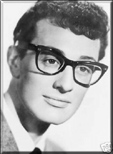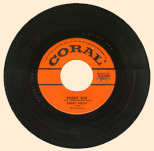|
It’s
been well over a half century, but I can still remember the sick feeling that
came over me when I heard the radio announcer tell of the deaths of
Buddy Holly, Big Bopper and Ritchie Valens in a plane crash. When my sister came home
and I told her, I could hardly speak the words.
Of course, since then we’ve lost many stars too soon, and there
were deaths before that – but this was a signal event to a
teenager in those early years of rock & roll.
Holly had been on the scene only two years, and as rock & roll
changed to rock in the sixties, his name seemed to fade. It was not
until the release of The Buddy
Holly Story, with Gary Busey’s masterful performance, that
Holly began to get the respect he deserves.
Now of course, he’s seen as an innovator and powerful influence.
Holly was one of the first rockers to write his own material and
pioneered such advanced studio techniques as double-tracking. He
popularized the now-standard rock-band lineup of two guitars, bass
and drums. In his final months, he even began experimenting with
orchestration.
Holly’s catalog of songs includes such standards of the rock and
roll canon as “Rave On,” “Peggy Sue,” “That’ll Be the
Day,” Oh Boy!” and “Maybe Baby.” He cut an engaging,
charismatic figure with his trademark horn-rimmed glasses and vocal
hiccup.
Born Charles Hardin Holley (later amended to “Holly”) on
September 7th, 1936, in
Lubbock, Texas, he learned to play guitar, piano and fiddle at an early age. Holly
was signed to Decca in early 1956, recording demos and singles for
the label in
Nashville under the name Buddy Holly and the Three Tunes.
On
February 25th, 1957, Holly and a revised band lineup, now dubbed the Crickets, recorded
“That’ll Be the Day” at the Clovis, New Mexico, studio of producer
Norman
Petty. The record became a number one pop hit and even rose to
number two on the R&B charts.
Having
split from the Crickets, Holly reluctantly agreed to perform on the
Winter Dance Party, an ill-advised bus tour of the
Midwest
in the winter of 1959. Following a show in Clear
Lake,
Iowa,
Holly chartered a private plane to the next stop on the tour, Moorhead,
Minnesota.
Two other performers, Ritchie Valens and the Big Bopper, joined him.
Their plane left the Mason
City,
Iowa,
airport at one in the morning and crashed in a cornfield a few
minutes later, killing all aboard. Buddy Holly was only 22 years old
at the time of the crash - an event immortalized in Don McLean’s
“American Pie” as “the day the music died.”
Buddy Holly's top ten hits:* "That'll Be the Day" (1),
"Peggy Sue" (3).
--Dick Estel, August 2006
*Billboard pop singles chart, as reported in the book Top 40
Hits, copyright 1992 by Joel Whitburn.
Some
material here was adapted from the Rock
& Roll Hall of Fame web site. |



